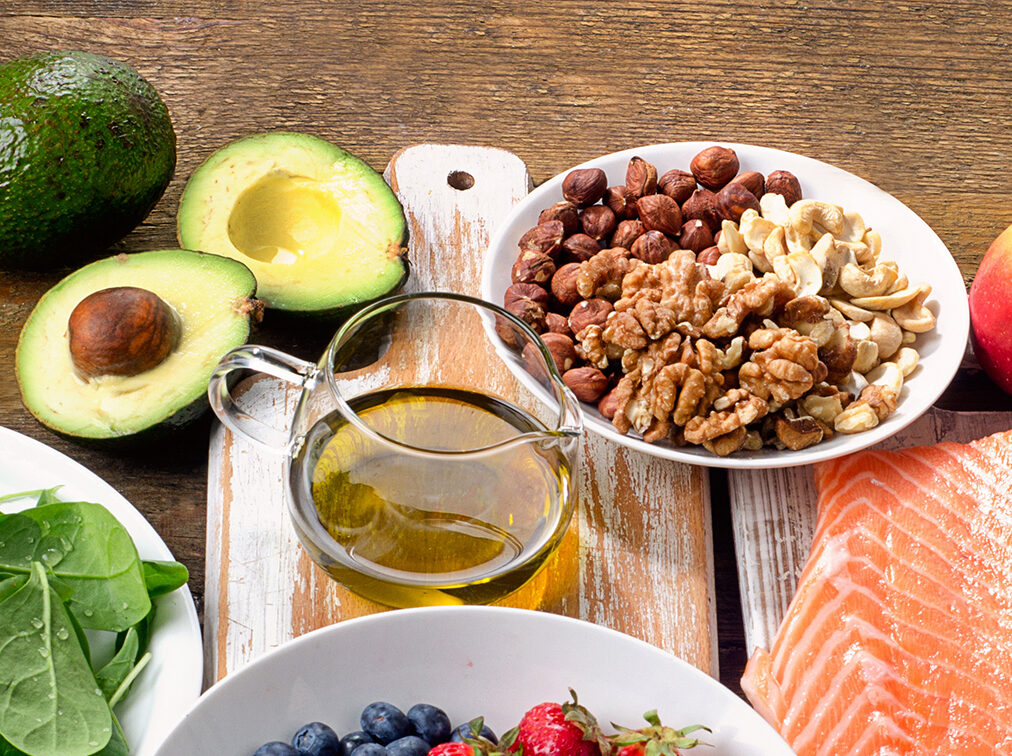A New You: Keeping Healthy New Year’s Resolutions
For those that couldn’t attend, the following is a summary of the presentation on New Year’s Resolutions.
The objectives of the presentation were:
- Identify one reason healthy lifestyles win over fad diets.
- Define the acronym for SMART goals.
- List one strategy you will use to stay on track.
The history of New Year’s resolutions go way back in time.
The earliest recorded history dates back to the 23rd century BC when Babylonians celebrated the first new moon after the vernal equinox- a time of the day and night when the time of darkness equaled the time of light. This event happened in March and was also the time when rulers renewed their commitments.
The Romans made promises each year in January to the god Janus (the Roman God of Beginnings). Romans celebrated by offering sacrifices to Janus, exchanging gifts with one another, decorating their homes with laurel branches and attending raucous parties.
In Medieval times, knights recommitted their chivalry each year after Christmas, known as the peacock vow. During this time period, religious holidays such as Christmas and the Annunciation took on more significance and it was not until Pope Gregory XIII in 1582 that New Year’s was reestablished.
To support the New Year, as many as 45% of the American population choose to make commitments for the beginning of the New Year.
Today many resolutions are geared towards physical wellbeing and external improvement, compared to historically, when they were focused more on good deeds. The Top 10 New Year’s resolutions today include:
- Lose Weight & Get Fit
- Quit Smoking
- Learn Something New
- Eat Healthier & Diet
- Get Out of Debt, Save Money
- Spend More Time with Family
- Travel to New Places
- Get Less Stressed
- Volunteer
- Drink Less
Note that half of the top 10 resolutions are health and wellness related: losing weight and getting fit, quitting smoking, eating healthier, going on a diet, getting less stressed and drinking less (alcohol).
Fewer than half of New Year’s Resolutions survive past February. Only 20% have a lifespan of 2 years or more and only 8% of New Year’s Resolutions are actually kept long term.
Why do resolutions fail?
- Goals are too big.
- Skills are not developed to maintain goals.
- Support systems are not in place to reach goals.
New Year’s resolutions should be lifestyle changes, and lifestyle changes require realistic goals, skills and support systems to be successful.
Goals allow us to remain focused and on task. However, goals that are too big or broad need to be broken down into S.M.A.R.T. goals to be successful for lasting lifestyle changes. S.M.A.R.T is an acronym for the 5 steps necessary in goal-setting. They stand for small, measurable, achievable, realistic, and timely. It’s a simple tool used to turn your New Year’s resolutions into an actionable plan for REAL results. Think of these as the stepping stones to reach your long term goals.
By immediately breaking down each large resolution into straight forward habits, your chances of succeeding will be 50% higher than if you leave it vague. Make it so simple for yourself to create that habit, that there is almost no way you can fail with it.
Start small, let’s say with vegetables at dinner (not all food groups, not vegetables at all meals, etc.). Make the goal measurable, say, 1 cup at dinner. Is 1 cup for you achievable? If not, maybe set the goal as ½ cup at first, then gradually increase. 5 nights a week might be realistic for you at first. If not, set the goal with a realistic number of nights to aim for. Lastly, the goal must have a time period—5 nights each week—so that at the end of the week, you will know if you succeeded in meeting your goal.
For each goal you set, think through the ‘SMART’ goal steps to set you up for success.
As you saw earlier, losing weight is the number one New Year’s resolution. Why do you think that is?
Given that 73.6% of adults in the United States are overweight and that we gain about a pound each year from the holiday season (which might not sound like much, but if we don’t lose that extra pound, consequently over the years those pounds add up!), that explains why the #1 New Year’s Resolution today is to lose weight.
With nearly 3/4 of Americans overweight – we are obsessed with Fad diets and their promises of quick weight loss and miraculous results. The revenue of the U.S. weight-loss industry, including diet books, diet drugs and weight-loss surgeries, is 20 billion dollars each year. Celebrities make millions each year endorsing weight loss products. American dieters attempt to lose weight 4 times per year.
Fad Diets Promise Quick Weight Loss & Miraculous Results
Fad diets may:
- Eliminate entire categories of foods (i.e. fat, sugar, carbs, etc.).
- Prescribe specific amounts of specific foods in specific combinations.
- Sell pills and powders.
- Recommend skipping meals or replace meals with specific bars or shakes.
Fad diets may be popular for a while, then die down…usually once the fad diet followers realize how difficult it is to continue to the diet long-term. And sometimes the diets resurface many years later, such as the case for the Atkins diet.
Since fad diets don’t work long term…what does? True lifestyle change includes following a healthy diet, regular physical activity and surrounding yourself with supportive people to help you sustain your lifestyle changes.
Dietary Guidelines for Americans:
- Follow a healthy dietary pattern to meet nutrition needs and help achieve a healthy body weight and reduce risk of chronic disease
- Customize and enjoy nutrient-dense food and beverage choices to reflect personal preferences
- Focus on meeting food group needs with nutrient-dense foods and beverages and stay within calorie limits
- Limit foods and beverages higher in added sugars, saturated fat, and sodium, and limit alcoholic beverages
Limits:
- Added sugars <10% of calories
- Saturated fat <10% of calories
- Sodium <2300mg per day
- Alcohol <2 drinks per day for men
- <1 drink per day for women
If you are one of the many people who set weight loss as their #1 New Year’s Resolution, aim for 1-2 lb weight loss per week. We all want to lose weight quickly, but the #1 thing that people who lose weight and keep it off have in common, is that they lose it at a steady pace of about 1-2 pounds per week. Sure, you can drop 10 lbs in a week, but chances are you are doing it by making drastic restrictions to your diet, and this will only lead to weight gain further down the road when you can no longer sustain these actions. With a loss of 1-2 lbs per week, you can steadily create long-term, realistic habits and changes that will last a lifetime. It’s true– Slow and steady wins the race every time!
So how do you lose those 1-2 lbs per week? 1 lb equals 3,500 calories so to lose 1-2 lb per week you need to eliminate 500 calories a day through diet and increase exercise (500 calories x 7 days a week= 3500 calories per week + deficit through exercise).
Slow and steady includes daily physical activity. At least 30 minutes a day of moderate physical activity is recommended for all adults, more for weight loss. Note that the more you weigh, the more calories you burn.
We are bombarded with so many weight loss tips today that it can be hard to dispel fact from fiction. Here are 4 tried-and-true, scientifically proven, ways to successfully reach your weight loss resolutions.
Stay motivated with these scientifically-proven weight loss tools:
- Buddy systems
- Goal setting
- Food diary (smartphone apps)
- Weight loss groups
The benefits of a buddy system have been proven time and time again.
-A university study cited in the Journal of Consulting and Clinical Psychology found that people who recruited three friends or family members to assist them in their quest to lose weight had better results losing and keeping weight off than those who had no buddy system to fall back on.
-A study from Indiana University showed that the 12-month drop-out rate for couples participating in a fitness program was just 6 percent, compared to 43 percent among individuals who joined the program alone.
But beware—it’s important to select your buddy wisely! You may love your best friend, but if they tend to be a food-pusher or not support your lifestyle changes, they may not be the right fit for your buddy. Here is what you should look for in the perfect buddy to help you succeed: 1) Honest-you want someone who is not afraid to speak the truth to you (as long as it’s in a way that will help you reach your goals), 2) Supportive—this goes without saying, 3) Motivating—you want someone who will make you want to be better. If exercise is a challenge for you, try teaming up with someone who makes time for the gym 3x a week so that you can be inspired by them, 4) Similar goals are important—It can be tough if your goal is to lose 10 lbs and your buddy needs to lose 50, 5) Someone who doesn’t hold you back– if you and your buddy plan to meet at the gym 3 days a week, but that buddy bails frequently (and therefore you decide to ditch as well) then it’s not a good fit; 6) Competitive in a healthy way– a little healthy competition never hurt anyone! Set a goal, for instance, the first person to lose 25 lbs (in a healthy way) will earn $25; Communicate in the same way—some people do better with a buddy they can talk to in person daily, others are fine checking in via email or text with a buddy who might be thousands of miles away! Choose a method that works best for both of you.
Next, let’s take a look at goal setting. A comprehensive review of studies (both lab and field) looking at the effects of goal setting and the success in completing that task was compiled and analyzed. The following 9 goal-setting steps were found to be the most effective:
Cultivate a positive attitude: How do you plan to succeed if you’re already doubting yourself to begin with, and dreading the task at hand? Approach your goal with a can-do, want-to-do attitude to boost your confidence and increase your chances of reaching that goal.
Goals should be specific, challenging, but realistic: We already talked about this with our S.M.A.R.T goals. Interestly, 90% of studies on goal setting found specific and challenging goals lead to higher performance than easy goals, “do your best” goals, or no goals.
Gather feedback on your progress: Check in with yourself or have someone/something holding you accountable on a regular basis. Your plans or goals may need to be adjusted slightly based on your progress, and that’s perfectly ok! Write your goals down on paper.
Celebrate the small stuff: Set mini-milestones that you can celebrate along the way to help you appreciate the journey and your success! Celebrate with non-food rewards like a new pair of running shoes or some quiet time for yourself!
Buddy Up: Whether it’s a friend, family member, coach or health professional it has to be someone you trust. The qualities we discussed in a good buddy pertain to this section. A buddy is a great person to share your goals and hold you accountable for your actions.
Create the goal for YOU: While setting a goal you don’t really want to achieve may sound strange, you’d be surprised at how many of us do this! We create goals based on what other people are setting as resolutions or what we think we should do, instead of setting goals that we REALLY want to do.
Break the goal into smaller mini-goals. To say you want to lose 50 lbs sounds so intimidating that you may not even know where to begin. But if you break it up into losing 1-2 lbs a week, or 4-8 lbs in a month, it makes your goals do-able.
Learn from setbacks: It’s important to be honest with yourself and what you are still struggling with on your weight loss journey. By acknowledging the obstacle, you can then proactively plan how you will overcome this challenge to reach your goal.
Pursue your goal whole-heartedly: There is no magic pill to help you lose weight. It takes time, effort and planning to get rid of old habits and replace them with new ones. Small steps can lead to big results, and as long as you’re doing 1 small thing to reach your goal every day, you are well on your way to success!
In weight loss studies, participants using mobile apps lost 2x more weight (and maintained the loss for at least a year) than those not using apps.
Because it’s still relatively new, research continues to emerge about the positive benefits of smartphone apps for weight loss success. One study found that app-assisted patients lost an average of 15 pounds and maintained the loss for at least a year. The participants outside the “mobile” group lost an average of 8.6 pounds per person.
Examples of apps are:
- MyFitnessPal
- LoseIt
- Sparkpeople
- MapMyRun
- CalorieKing
- FitBit
- Fooducate (grocery shopping)
Why are these apps so effective? This approach empowers users to help themselves and make their lifestyle changes a priority on a day-to-day basis. These apps engage you to track your own eating and activity patterns, teaches you how that can affect weight gain/loss, and has the benefits of a built in social network support!
Group Weight Loss:
64% percent of corporate wellness program participants say they are more likely to push themselves harder in a group setting than when they go it alone. (Source: Virgin Health Miles)
Why are group weight loss programs so effective?
- Support System: Weight loss support groups may offer that supportive foundation needed for anyone making major lifestyle changes. You are surrounded by others you can relate to, and who are dealing or have dealt with similar weight loss challenges. You have a built-in network of friends who are there to listen to your struggles and encourage you to continue with your weight loss journey.
- Structure: The structure of weight loss support groups makes it easier to stay on track with your goals, and check in (usually on a weekly basis) with your progress. This structure makes it difficult to fall off the wagon because you are constantly being reminded of what you need to do within a certain time frame. You are also setting smaller, more realistic goals rather than becoming overwhelmed by the big picture or end goal.
- Socializing & Stress Relief: Knowing you are surrounded by a group of people who are helping you stay accountable, and having an outlet to discuss your successes and challenges can help relieve any anxiety you may be experiencing related to weight loss. Studies actually show that people who attend weight loss support group meetings have lower levels of the stress hormone, cortisol, than those who attempt it alone. High cortisol levels are associated with weight gain, especially in the midsection, so the lower your stress/cortisol levels…the easier the weight will come off!
- Effective Strategies: There is a reason why Weight Watchers and other weight loss support groups are so popular. It’s because these groups provide you the resources and tools to succeed—from recipes, to workout routines, to meal plans, and active online communities specially designed to help you meet your goals.
To conquer your New Year’s resolutions for good, remember:
- Healthy lifestyles always win over fad diets
- Set realistic goals using SMART goals
- Have a plan to stay on track with a strong support system (whether buddy, group, or app!)







